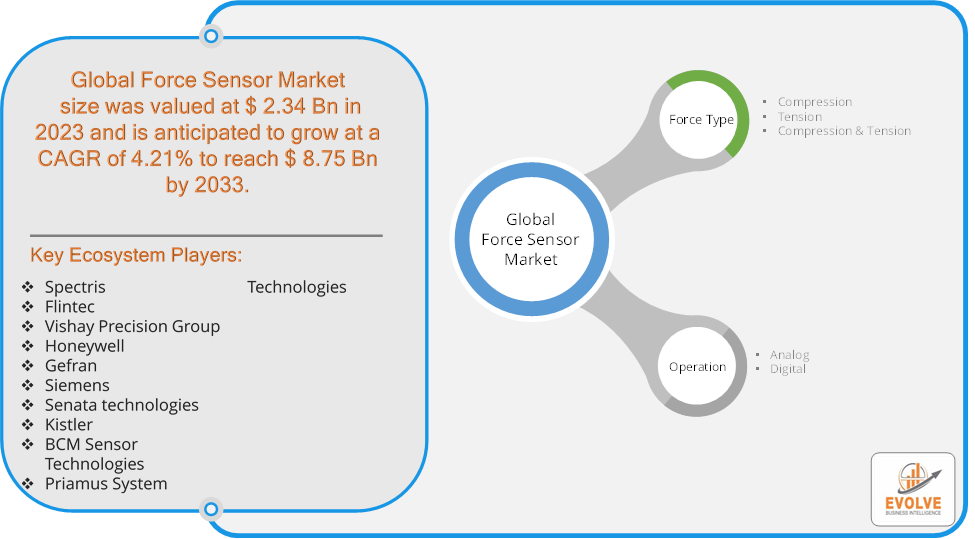Force Sensor Market Growth: 4.21% CAGR Forecast

Evolve Business Intelligence has published a research report on the Global Force Sensor Market, 2023–2033. The global Force Sensor Market is projected to exhibit a CAGR of around 4.21% during the forecast period of 2023 to 2033.
Evolve Business Intelligence has recognized the following companies as the key players in the global Force Sensor Market: Spectris, Flintec, Vishay Precision Group, Honeywell, Gefran, Siemens, Senata technologies, Kistler, BCM Sensor Technologies and Priamus System Technologies.
 More Information: https://evolvebi.com/report/force-sensor-market-analysis/
More Information: https://evolvebi.com/report/force-sensor-market-analysis/
Market Highlights
The Global Force Sensor Market is projected to be valued at USD 8.75 Billion by 2033, recording a CAGR of around 4.21% during the forecast period. The Force Sensor Market refers to the global industry involved in the development, production, and sales of force sensors. These sensors are devices that measure the amount of force applied to an object and convert this measurement into a readable output, typically in the form of electrical signals.
The market encompasses various types of force sensors, including load cells, strain gauges, piezoelectric sensors, and capacitive force sensors. It is driven by technological advancements, increasing demand for automation, and the growing adoption of force sensors in emerging applications such as IoT devices and smart wearables.
The COVID-19 pandemic had a significant impact on the Force Sensor Market. The pandemic caused substantial disruptions in global supply chains due to lockdowns, factory shutdowns, and restrictions on transportation. This led to delays in the production and delivery of force sensors and related components. The pandemic accelerated the adoption of automation and robotics in various industries to maintain productivity while adhering to social distancing norms. This increased the demand for force sensors in automated systems and robotic applications. With travel restrictions and remote work policies in place, there was a reduction in field services and on-site installations of force sensor systems. This impacted the deployment and maintenance activities of these sensors. The pandemic highlighted the importance of robust and resilient supply chains, which is expected to drive long-term changes in the force sensor market. Companies may diversify their supplier base and invest in local manufacturing to mitigate future risks.
Segmental Analysis
The global Force Sensor Market has been segmented based on Force Type and Operation.
Based on Force Type, the Force Sensor Market is segmented into Compression, Tension and Compression & Tension. The Compression & Tension segment is anticipated to dominate the market.
Based on Operation, the global Force Sensor Market has been divided into the Analog and Digital. The Analog segment is anticipated to dominate the market.
More Information: https://evolvebi.com/report/force-sensor-market-analysis/
Regional Analysis
The Force Sensor Market is divided into five regions: North America, Europe, Asia-Pacific, South America, and the Middle East, & Africa. North America, particularly the United States, is a hub for technological innovation. The presence of major tech companies and extensive research and development activities drive the adoption of advanced force sensors. High adoption of automation and Industry 4.0 technologies in manufacturing industries boosts the demand for force sensors in industrial applications. Europe is home to leading automotive manufacturers in countries like Germany, France, and Italy. The focus on electric vehicles and autonomous driving increases the need for force sensors. Europe’s advanced healthcare infrastructure and strong medical device manufacturing industry drive the demand for force sensors in various medical applications. The Asia-Pacific region is a major hub for consumer electronics manufacturing, with significant demand for force sensors in devices such as smartphones, tablets, and wearables. Rapid industrialization and economic growth in countries like China, India, Japan, and South Korea drive the demand for force sensors in manufacturing and industrial applications. In Latin America region, Countries like Brazil and Mexico are experiencing industrial growth, leading to increased demand for automation and force sensors in manufacturing processes. Growing investments in healthcare infrastructure and medical devices create opportunities for force sensors in the region. The Middle East and Africa region is witnessing gradual industrial development, particularly in countries like the UAE, Saudi Arabia, and South Africa, which drives the demand for force sensors in industrial applications. Increasing investments in healthcare infrastructure and medical technology in the Middle East and parts of Africa create opportunities for force sensor applications in medical devices.
